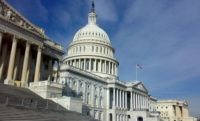In a significant, but far from final, step for infrastructure legislation, President Joe Biden and a bipartisan group of Senators have reached agreement to provide an additional $579 billion over five years for a wide range of programs, including highways, transit, energy and broadband.
“We have a deal,” Biden announced on June 24, speaking to reporters outside the White House.
[View detailed breakdown of framework's funding, from Senators here.]
The agreement follows days of negotiations between top White House aides and members of a bipartisan group of Senators. Initially, the group numbered 10, later growing to 21.
The productive talks came after the failure of a lengthier round of infrastructure negotiations between the White House and Senate Republicans. Those discussions ended on June 8, with no agreement.
After pushing for an infrastructure plan for years, engineering and construction industry groups hailed the news of the bipartisan deal.
Steve Hall, American Council of Engineering Companies’ senior vice president for advocacy, said in an interview, “It really does create that dynamic that a significant infrastructure package is actually going to be a reality this year.”
The plan “has the potential to provide a windfall for the U.S. construction industry and provide a much-needed shot in the arm for the nation’s infrastructure,” Kevin Plexico, senior vice president of information solutions at software company Deltek, said in a statement.
David Bauer, American Road & Transportation Builders Association president and CEO, told ENR in an interview: “There are a lot of things to like about this—a bipartisan agreement, White House enthusiasm.” But he cautions, “This is by no means rounding third and heading to home.” He adds, “There’s a lot of work that has to happen.”
“Since there’s no legislative text right now, we don’t know what the specifics of the policy will be, let alone how they will put this all together.” Michele Stanley, National Stone, Sand & Gravel Association vice president of government and regulatory affairs, said in comments emailed to ENR. Lawmakers might choose to pass bills for each sector separately or combine them into one big package, she suggests.
Once the framework is fleshed out in legislative language, it still must win enough votes for approval in the Senate and House.
Biden also underscored that the “physical infrastructure” measure that’s the subject of the bipartisan deal is only half of a “tandem” of envisioned legislative packages.
The other is a larger proposal covering what he calls “human infrastructure.” It would include funding for such things as child care and education and clean energy tax cuts.
Democrats say the physical infrastructure legislation would move through Congress under conventional procedures. Some potentially key parts of that measure—notably, surface transportation and wastewater treatment-drinking water bills—already have made significant progress in the House and Senate in recent weeks.
But Biden says the human infrastructure proposal would take a different path, moving under the budget reconciliation process. Reconciliation would permit Democrats to get a bill through the Senate with a simple majority, not the higher, 60-vote threshold needed to block a filibuster. The Senate’s party split is 50-50, with Vice President Kamala Harris casting tie-breaking votes for Democrats.
Biden links physical to human infrastructure measure
Biden told reporters in a press conference later on June 24 that he would not sign the physical-infrastructure bill until Congress also passes the human infrastructure measure.
That stance drew sharp criticism from Senate Minority Leader Mitch McConnell (R-Ky.), who said it “would hold the bipartisan [infrastructure] agreement hostage, demanding trillions of dollars in wasteful spending and job-killing tax increases in return for even considering it.”
Associated Builders and Contractors also is concerned about Biden’s two-part approach, says Michael Bellaman, ABC president and CEO. He said in a statement that the plan would seek to link the infrastructure measure with a package under reconciliation that would “enact partisan tax hikes and restrictive labor policies concurrent with any potential bipartisan agreement.”
The White House calculates the new framework’s cost at $973 billion over five years and also cites a figure of $1.2 trillion over eight years. But the “new money”—that is, the amount above current “baseline” spending—is estimated at $579 billion.
Stanley said that “this is a great first step and any amount over current baseline is welcomed.” She adds, “The certainty of these funds is crucial.”
Hall says ACEC would have preferred to see the new agreement include some of Biden’s earlier proposals for “vertical” infrastructure, such as public buildings and school facilities.
He says, “Obviously, we’re always going to be very, very supportive of bigger, and more. But having said that, there’s a lot here. And it’s checking a lot of boxes and addressing a lot of needs.”
The largest item is $109 billion for highways, bridges and other major surface transportation projects, according to a White House summary.
Public transit would receive $49 billion; passenger and freight rail would get $66 billion; and airports would be allotted $25 billion.
Biden said he had sought $15 billion for charging stations and other infrastructure for electric vehicles, but settled for $7.5 billion.
Water infrastructure, including funds for wastewater treatment projects and removing aging lead drinking-water pipes, would receive $55 billion.
Power infrastructure including the electric grid, would be in line for $73 billion, including upgraded transmission lines and a new Grid Authority; broadband infrastructure would receive $65 billion.
Environmental cleanup would get $21 billion.
Steps to make infrastructure more resilient in the face of hurricanes, wildfires and other natural disasters, also are in the package, with an allocation of $47 billion.
Menu offers 13 financing options
The agreement also includes a 13-item menu of proposed ways to finance the ambitious framework. But the White House summary doesn't rank those possible “pay-fors” in priority order. Nor does it specify how much revenue each option would raise.
Opposition from Biden kept some possible “pay-fors” out of the package, such as raising the federal gas tax or indexing in for inflation.
On the other hand, opposition from Republicans put other options off the table, such as rolling back part of the 2017 corporate tax rate cuts.
Among the revenue options that did make the cut is reducing the Internal Revenue Service “tax gap"—the difference between what taxpayers are supposed to pay and how much they actually pay.
Also on the list are redirecting already approved funding to states for unemployment insurance programs and tapping state and local government funding for some broadband expansions.
Other items include public-private partnerships, private-activity bonds and direct-pay bonds. In addition, the plan calls for a new Infrastructure Financing Authority.
More revenue could come from the "macroeconomic impact of infrastructure investment," the summary says, without elaborating.
Story corrected on 6/29/2021: Michele Stanley's title at National Stone, Sand & Gravel Association is vice president of government and regulatory affairs.






Post a comment to this article
Report Abusive Comment